Page snapshot: Quick facts about sorghum: What it is, where it came from, how it is used, how it is grown, and where it is grown.
Topics covered on this page: What is sorghum?; Where did sorghum come from?; How is sorghum used?; How is sorghum grown?; Where is sorghum grown?; Resources.
Credits: Funded by the National Science Foundation. Any opinions, findings, and conclusions or recommendations expressed in this material are those of the author(s) and do not necessarily reflect the views of the National Science Foundation. Page by Elizabeth J. Hermsen (2023).
Updates: Page last updated March 12, 2023.
Image above: Cultivated grain sorghum, El Campo, Texas, 2013. Photo by Lance Cheung, USDA (USDA on flickr, public domain).
What is sorghum?
Sorghum (Sorghum bicolor) or milo (among other names) is a tropical grass that is grown primarily for its grain, although sweet sorghum (sorgo) is grown for the sugar-rich juice in its stem, and broomcorn is grown for its branches. Sorghum produces small, round grains that are often white or red in color. The scientific naming of wild and domesticated sorghum species is complicated, although the domesticated forms are now usually placed in Sorghum bicolor subspecies bicolor.
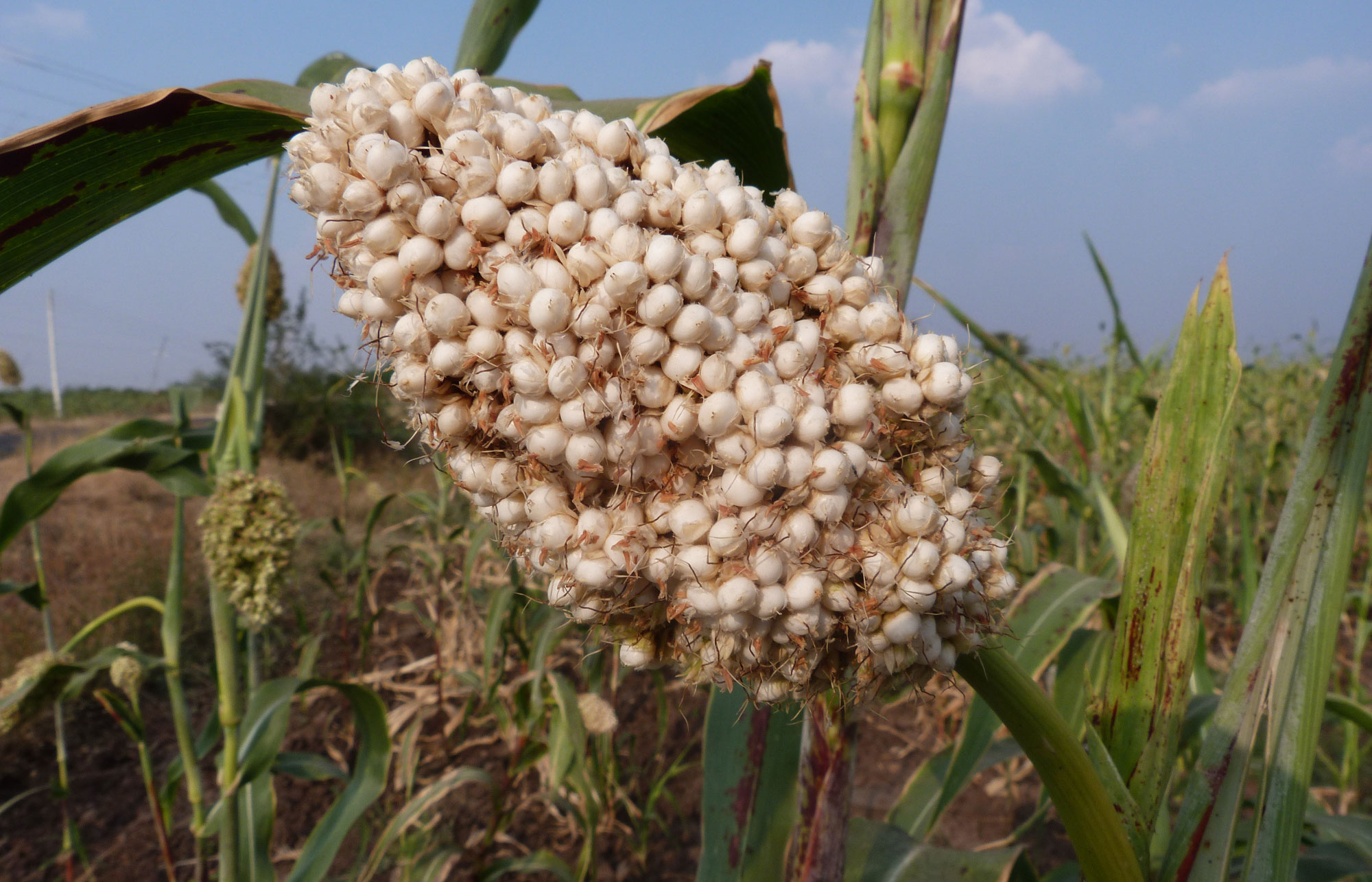
Sorghum or jowar (Sorghum bicolor), Maharashtra, India. Photo by MGB CEE (Wikimedia Commons, Creative Commons Attribution-ShareAlike 4.0 International license, image cropped and resized).

Original caption: "Paul Cochran, a farmer from Portland, cuts slices of sweet sorghum stalk to taste for sweetness. Drs. Nilda Burgos and Leopoldo Estorninos and Jerry Gregory, a certified crop consultant from Lake Village, look on during a field day at the University of Arknasas Division of Agriculture's Rohwer Research Station." Photo source: AAES Director on flickr (Creative Commons Attribution-ShareAlike 2.0 Generic license, image resized).
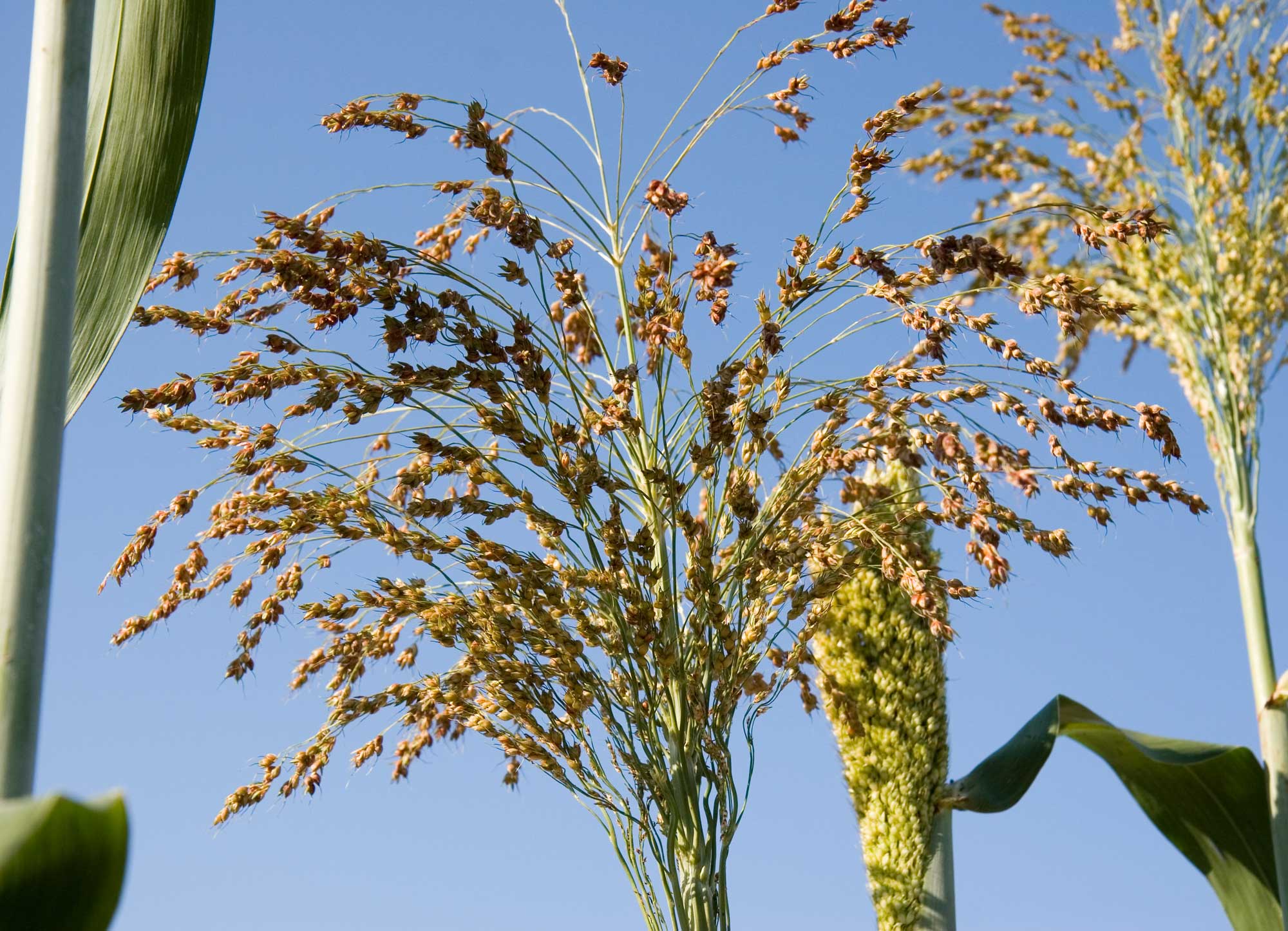
Broomcorn. Photo by Wally Hartshorn (flickr, Creative Commons Attribution-NonCommercial 2.0 Generic license, image resized).
Where did sorghum come from?
Scientists think that sorghum was domesticated from a wild form of sorghum more than 5000 years ago in the region of present-day Sudan. Cultivation of sorghum later spread to other regions, including India, other parts of Africa, East Asia, and the Mediterranean region, before sorghum was brought to the Americas.
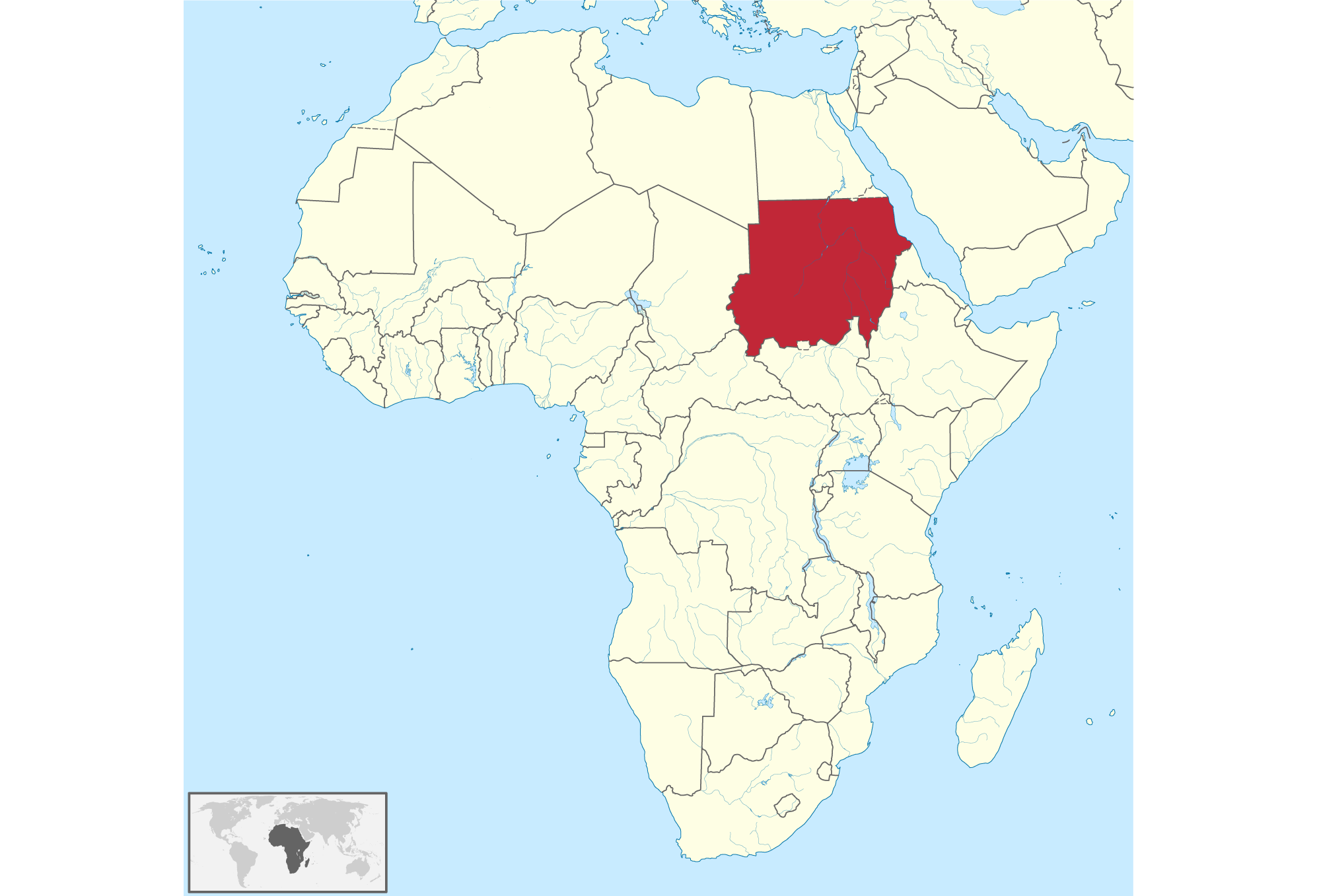
Map showing the location of Sudan. Map by TUBS (Wikimedia Commons, Creative Commons Attribution-ShareAlike 3.0 Unported license, image modified).
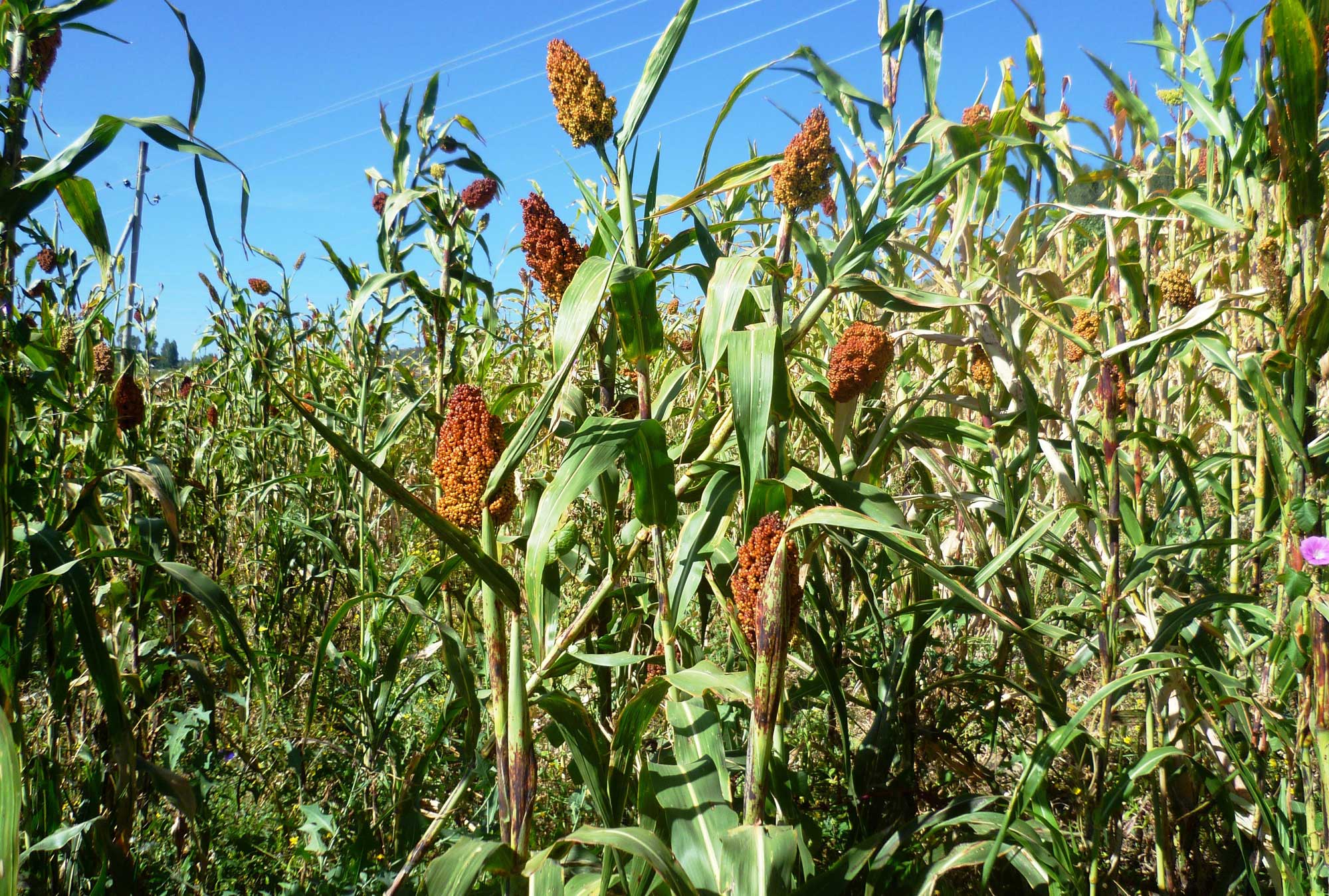
Sorghum crop in Amara, Ethiopia, a region of Ethiopia bordering Sudan. Photo by Radosław Botev (Wikimedia Commons, Creative Commons Attribution 3.0 Poland, image cropped and resized).
How is sorghum used?
Sorghum is cultivated for its grain, which is an important food source for people living in dry tropical and subtropical regions of the world. Sorghum grain, stems, and leaves are also used as livestock feed and fodder. Sorghum grain can be fermented to make beverages. Fermented sorghum beverages are traditionally brewed in parts of Africa (for example, dolo, ikigage, or tchapalo). Commercial brewers are also exploiting sorghum for use in gluten-free beers.
Sweet sorghum or sorgo accumulates sucrose (a sugar) in its stem. Sweet sorghum stems can be crushed to extract the sugary juice, which an be processed into sorghum syrup. The juice can also be fermented and distilled to make sorghum rum. Sweet sorghum is of interest for producing biofuels, although it is not yet widely exploited for that purpose, unlike maize and sugarcane.
Broomcorn inflorescences are used in some types of decorations, as well as in natural-bristle brooms.

Sorghum porridge. Photo by Jon Mountjoy (flickr, Creative Commons Attribution 2.0 Generic license, image cropped and resized).
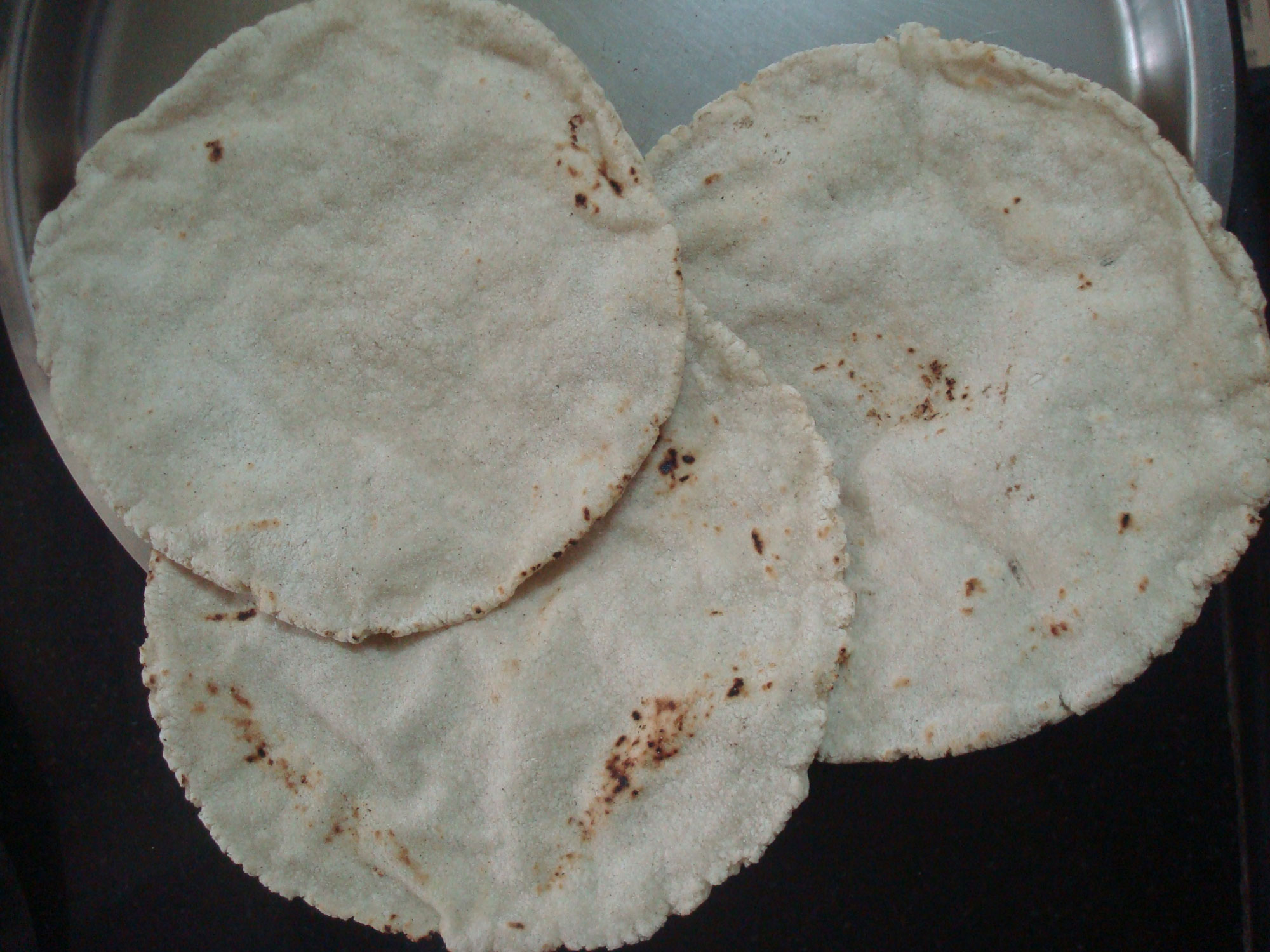
Bhakri (flat bread) made from jowar (sorghum) flour. Bharkri is made in certain parts of India. Photo by Dharmadhyaksha (Wikimedia Commons, Creative Commons Attribution-ShareAlike 4.0 International license, image resized).

Cattle grazing on sorghum stalks in a field, Kenya, 2005. Photo by ICRISAT/M. Winslow (flickr, Creative Commons Attribution-NonCommercial 2.0 Generic license, image cropped and resized).
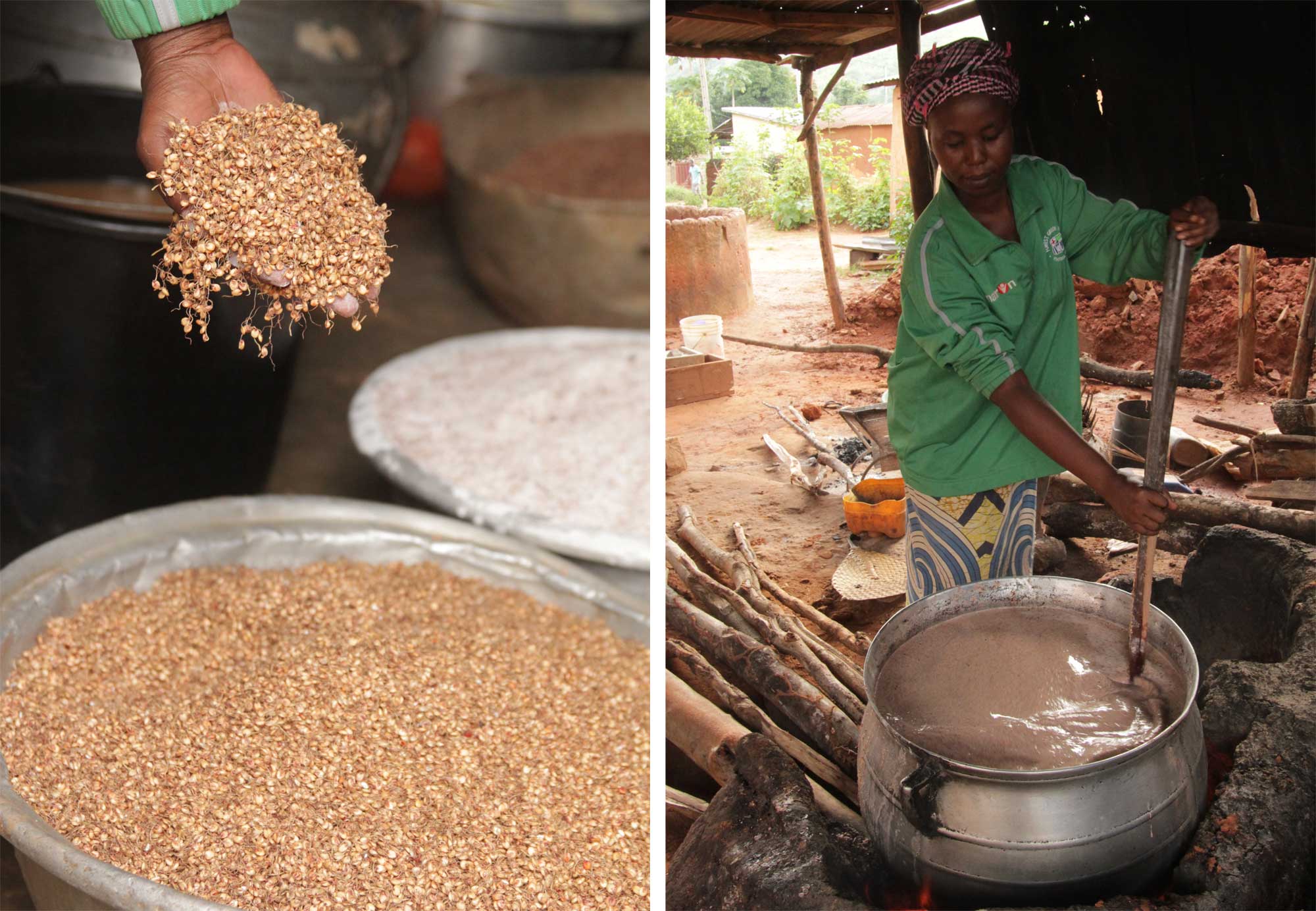
Preparation of tchoukoutou, a fermented beverage made from sorghum grain, in Benin, 2017. Left: Malted (sprouted, dried) sorghum. Malting releases enzymes that break down the starch in grains, converting it to sugars that can be fermented by yeast. Right: Tchoukoutou brewing. Left photo and right photo by Abby Wendle (Wikimedia Commons, Creative Commons Attribution-ShareAlike 4.0 International license, image cropped and resized).
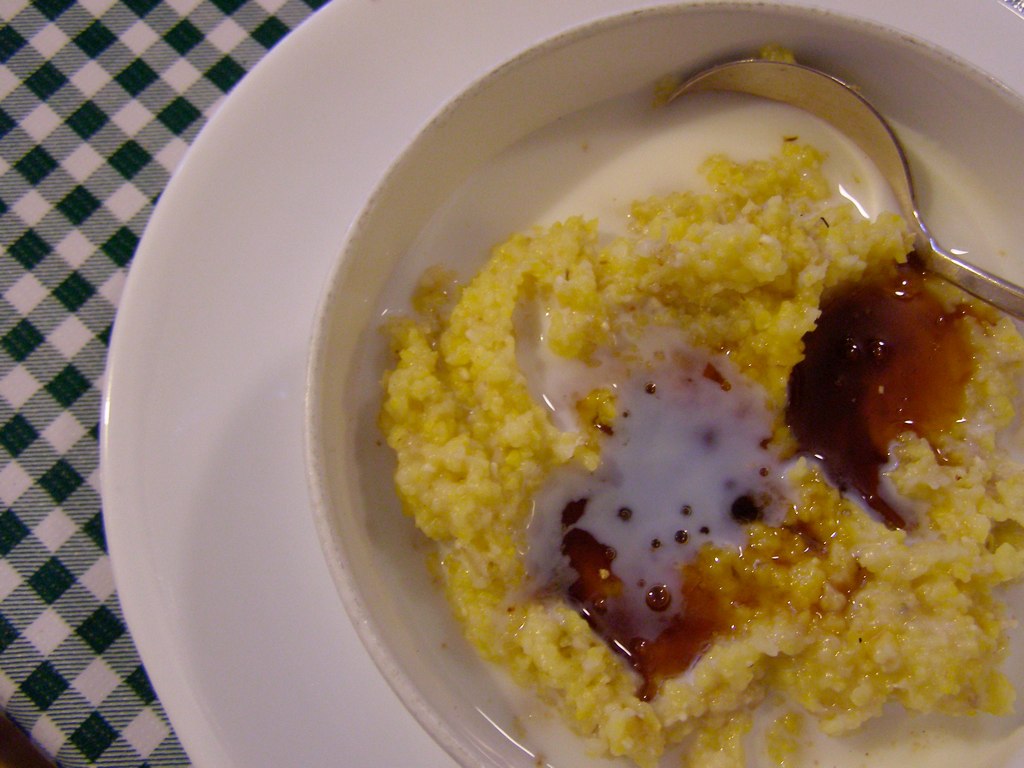
Grits (ground maize) and milk with sorghum syrup. Grits are a traditional food in the southeastern U.S. Photo by Melinda Young Stuart (flickr, Creative Commons Attribution-NonCommercial-NoDerivs 2.0 Generic license).
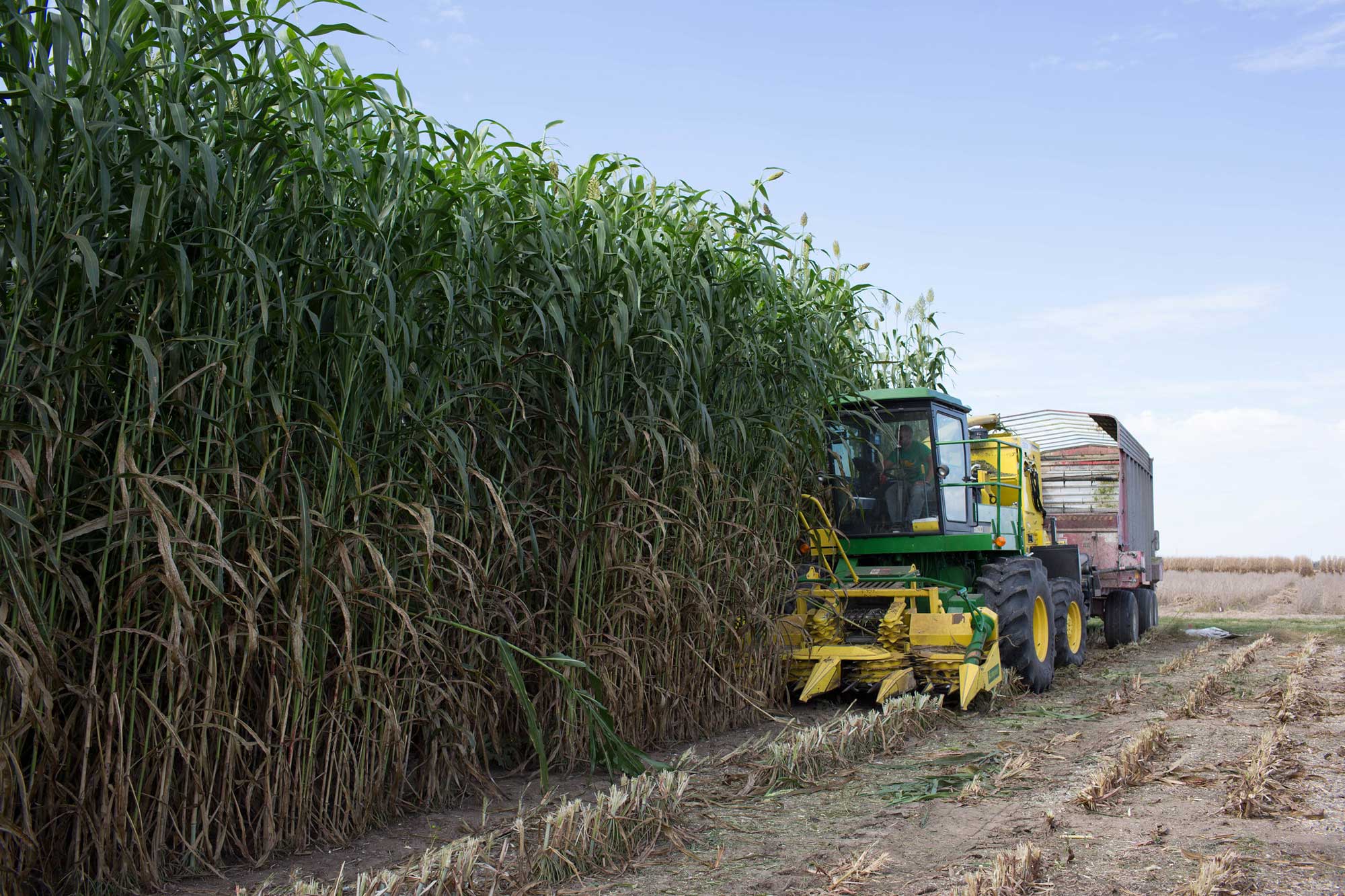
Tall sorghum plants engineered to produce bio-oil for fuel being machine-harvested. Photo by Claire Benjamin (PETROSS, TERRA-MEPP & WEST on flickr, Creative Commons Attribution 2.0 Generic license, image resized).
How is sorghum grown?
Like other grass grain crops, sorghum is grown in cultivated fields. Grain sorghum is grown from seed as an annual crop, meaning that it reaches maturity in one growing season. Sorghum is primarily a self-pollinated plant, and pollination and fertilization are important to grain yields.
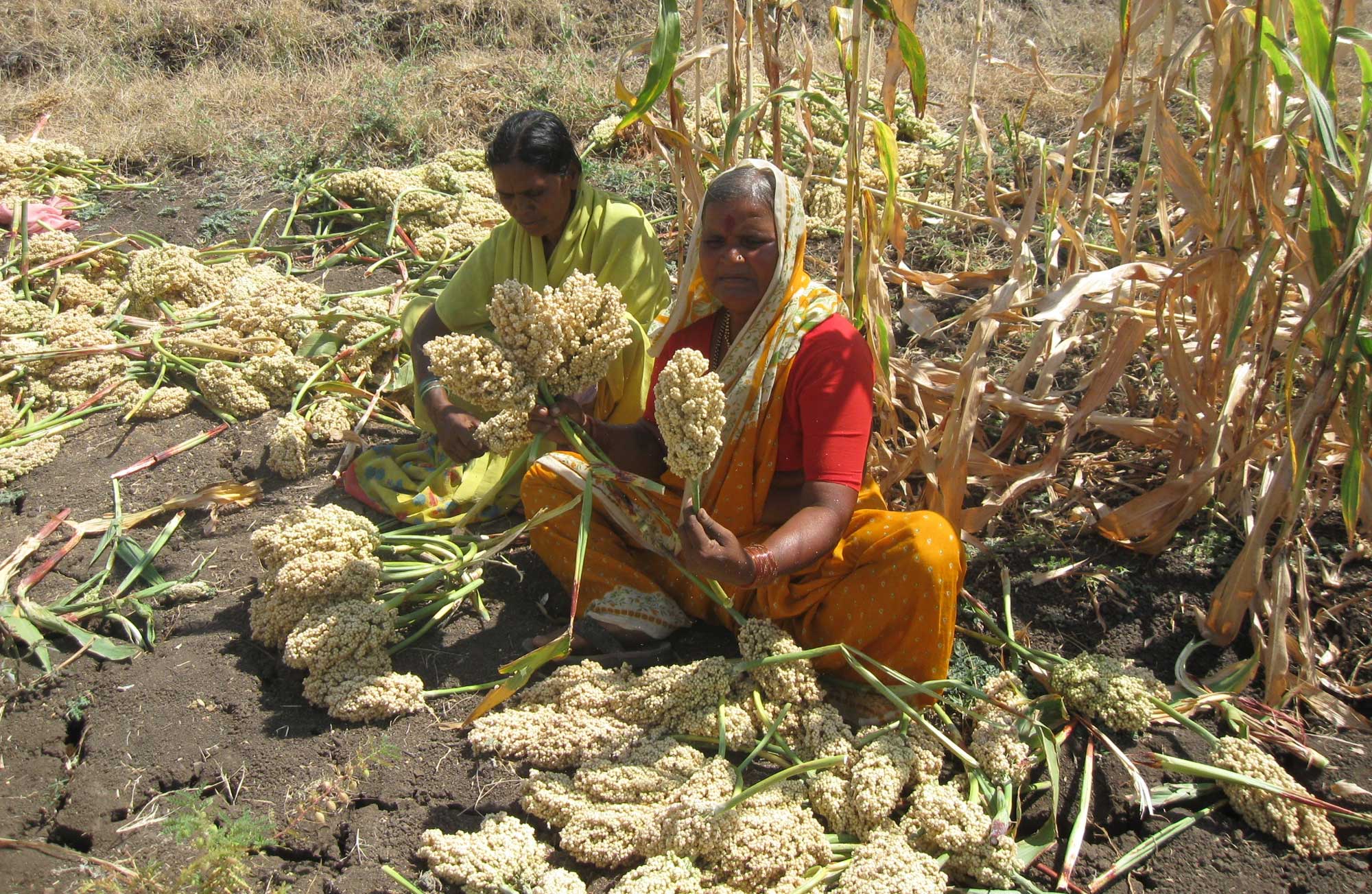
Farmers saving sorghum panicles for seed, Maharashtra, India, 2010. Photo by ICRISAT (flickr, Creative Commons Attribution-NonCommercial 2.0 Generic license, image cropped and resized).
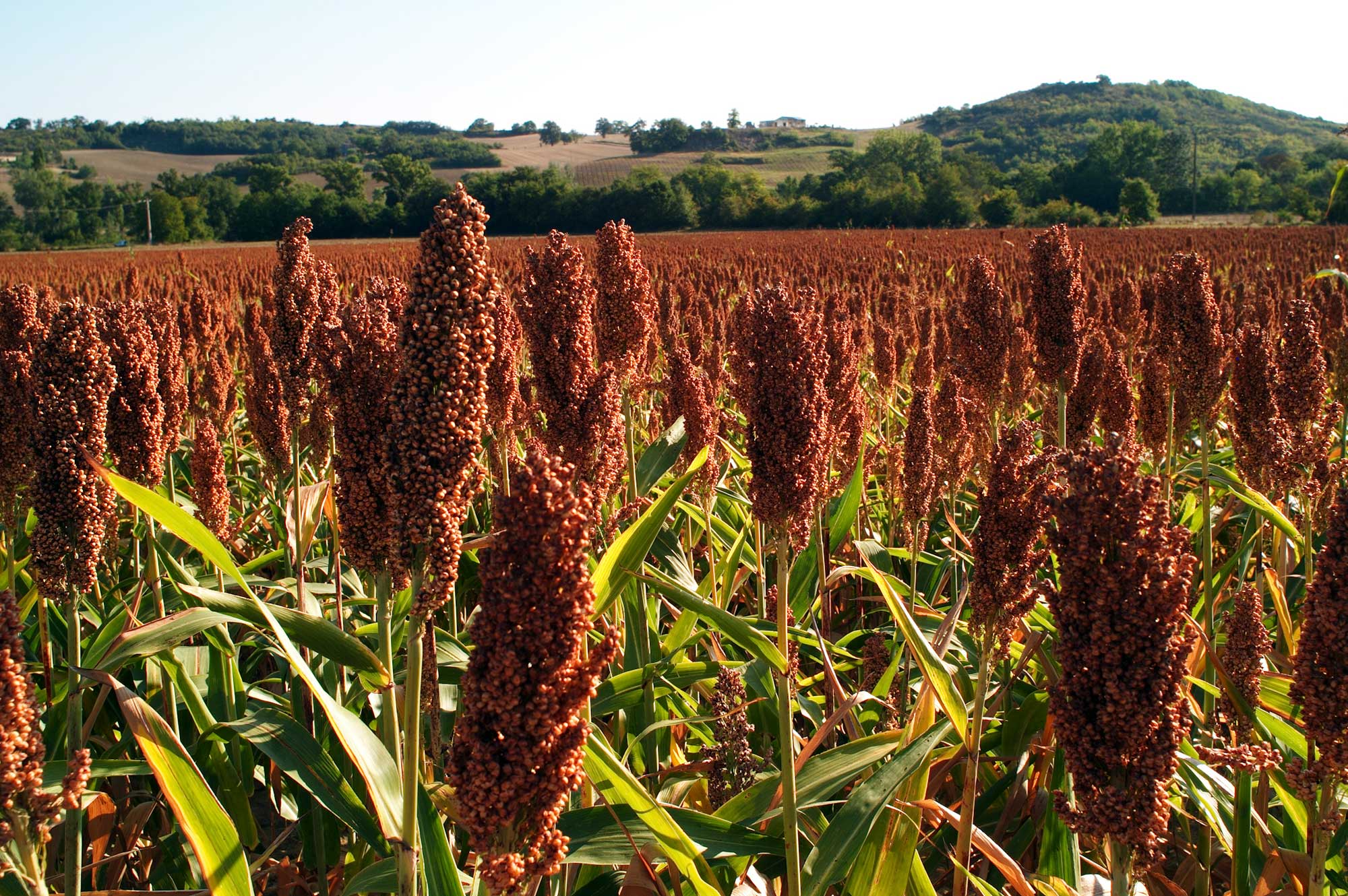
Cultivated sorghum (Sorghum bicolor), France. Photo by Jean Weber (flickr, Creative Commons Attribution 2.0 Generic license, image resized).

Hand-harvesting sorghum, Port-au-Prince, Haiti, 2014. Photo by SOIL (flickr, Creative Commons Attribution 2.0 Generic license, image resized).

Mechanized sorghum grain harvesting, Navasota, Texas, U.S.A., 2013. Photo by Bob Nichols/USDA (flickr, Creative Commons Attribution 2.0 Generic license, image resized).
Where is sorghum grown?
Sorghum can be grown in large parts of the temperate zone because it is an annual crop that does not require an extremely long growing season. Today, sorghum is the world's number five cereal (grass grain) crop, after maize, wheat, rice, and barley. The top producers of sorghum are the United States and Nigeria, followed by Ethiopia, India, Mexico, and China.

World map of sorghum production in 2020 by country. Map from Our World in Data (Creative Commons Attribution 4.0 International license, image resized).
Resources
Websites
Plants Engineered to Replace Oil in Sugarcane and Sweet Sorghum (PETROSS): https://petross.illinois.edu/
Sweet sorghum research (I. Dweikat, University of Nebraska-Lincoln Department of Agronomy and Horticulture): https://agronomy.unl.edu/sweetsorghum
Tchoukoutou (C. Seidl, Gastro Obscura): https://www.atlasobscura.com/foods/tchoukoutou-togo-beer
Articles
Charles, D. 2013. Heat, drought draw farmers back to sorghum, the 'camel of crops.' The Salt, October 31, 2013. https://www.npr.org/sections/thesalt/2013/10/31/231509864/heat-drought-draw-farmers-back-to-sorghum-the-camel-of-crops
Curtis, W. 2016. Making sense of sorghum rum. Distiller, July 1, 2016. https://distilling.com/distillermagazine/making-sense-of-sorghum-rum/
Ezeanya-Esiobu, C. 2019. The role of rural women in making home brew: a Rwandan case study. The Conversation, May 5, 2019. https://theconversation.com/the-role-of-rural-women-in-making-home-brew-a-rwandan-case-study-76805
Farm Energy. 2019. Sweet sorghum for biofuel production. April 3, 2019. https://farm-energy.extension.org/sweet-sorghum-for-biofuel-production/
Heuzé V., G. Tran, and F. Lebas F. 2015. Sorghum grain. Feedipedia. https://www.feedipedia.org/node/224
Heuzé, V., G. Tran, S. Giger-Reverdin, and F. Lebas. 2015. Sorghum forage. Feedipedia. https://www.feedipedia.org/node/379
Rajvanshi, A. K. 2018. From food to fodder, here's how this magic plant can take care of our needs. The Better India, December 20, 2018. https://www.thebetterindia.com/167321/sugar-replacement-eco-friendly-ethanol-production-india/
U.K. Cooperative Extension Service. 2013. Broomcorn. PDF: https://www.uky.edu/ccd/sites/www.uky.edu.ccd/files/broomcorn.pdf
Books
Levetin, P., and D. S. McMahon. 2016. Plants and Society, 7th ed. McGraw Hill Education, New York.
Simpson, B. B., and M. C. Ogorzaly. 2001. Economic botany, plants in our world, 3rd ed. McGraw Hill Higher Education, New York, New York.
Stewart, Amy. 2013. The Drunken Botanist. Algonquin Books of Chapel Hill, Chapel Hill, North Carolina.
Scientific articles
Fuller, D. Q., and C. J. Stevens. 2018. Sorghum domestication and diversification: a current archaeobotanical perspective. Pp. 427-452 in A. Mercuri, A. D'Andrea, R. Fornaciari, and A. Höhn (eds.) Plants and people in the African past. Springer, Cham. https://doi.org/10.1007/978-3-319-89839-1_19



